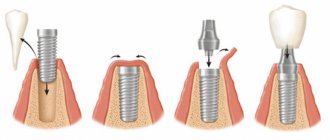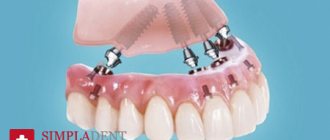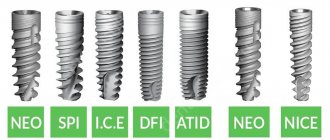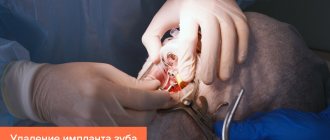It’s a long wait for the artificial root to engraft, then for the formation of a gum ridge and get a beautiful smile in six months. And this is only if it was not necessary to additionally build up bone tissue. Otherwise, the treatment will take twice as long. The prospect is not very bright, you will agree. At the Ilatan Clinic, implant installation is carried out immediately after tooth extraction. This is a reliable method that allows you to minimize interference in the dental system and quickly restore the missing unit. Often, the implant can be immediately loaded with a crown - the patient will immediately receive a new tooth.
When can an implant be installed immediately after tooth extraction?
Indications for emergency implantation are:
- The presence of mobile, damaged teeth and roots that need to be removed;
- single, multiple restorations;
- tooth injury, with the inability to save it;
- fracture, crack of a tooth root;
- perforation of the dental canal during filling.
But installing an implant after tooth extraction is not always possible.
The doctor plans the procedure in advance, and a comprehensive diagnosis is required to assess the possibility of a one-time installation. In case of emergency removal without the necessary examination, the method is not used. In addition, the patient should not have contraindications to implantation and surgical interventions in general.
Good quality and sufficient volume of bone is important. If there is inflammation, a cyst, or any other pathological focus on the root of the extracted tooth, immediate implantation is not performed. Also, the procedure will have to be postponed if the removal was traumatic or the alveolar process was severely damaged.
Implantation methods
- Classic two-stage - implantation occurs no earlier than 2-3 months after extraction. Prosthetics are performed at the second stage after osseointegration.
- One-stage installation (instant, instant) - implantation of a titanium root into a fresh socket with sutures or installation of a gum former. Prosthetics can be performed immediately after surgery or after the implant has healed.
- One-stage installation with immediate loading - implantation with a load in the form of a temporary crown on the day of surgery.
Classic way
The traditional method has been widely used in dental practice for more than 30 years. The peculiarity is the duration of treatment, which can take up to 1 year .
Classic implantation is carried out when the wound has completely healed after tooth extraction and bone has been restored. Often there is a need to build up the latter, which delays the installation for another 4-5 months. After the socket has healed, the gum is pierced or cut to place the implant. The final stage of prosthetics occurs 4-6 months after installation.
Immediate installation of implants
Implantation is possible if there is a neat hole after extraction. The success of the operation can only be predicted after the tooth is extracted. The installed implant is covered with mucous membrane and sutures are applied. A healing abutment may be placed to maintain the “pink aesthetic.” The healing stage may be accompanied by wearing a temporary removable nylon or adhesive bridge. The method is relevant in the absence of contraindications.
Advantages of one-stage implantation
The following advantages are associated with installing an implant after tooth extraction:
- Reducing treatment time;
- minimal trauma - no re-operation or formation of a bed for the implant is required in the bone;
- no need for bone grafting;
- preservation of the natural gum contour;
- the ability to immediately load the titanium root with a prosthesis.
If there are all conditions for immediate implantation, this opportunity should be used. The advantages of the technique of installing an implant in the socket of an extracted tooth are especially relevant in the smile area. The implant is immediately implanted without surgery - the tooth is removed from the socket, and a titanium root is screwed in its place. More often, immediately covering it with a prosthesis.
Implantation of long-extracted teeth
Long-term absence of a tooth is fraught with thinning and atrophy of the bone. Under such conditions, the implant will not be able to be firmly fixed and function normally. The layer of bone tissue covering the structure will be too thin (less than 2 mm). Subsequently, bone destruction will occur and the upper part of the implant will be exposed.
Installation of an artificial root in place of a long-lost unit is possible only after bone grafting . This is done in one of the following ways:
- Splitting of the alveolar process - the atrophied area of the bone is sawed longitudinally. An implant is implanted into the resulting hole. The empty space is filled with a fixing substance and sutures are applied. Crown installation is possible in 2-4 months.
- Bone block transplantation (autotransplantation) - bone tissue is used from other parts of the patient’s or donor’s jaw. Engraftment lasts at least 6 months.
- Guided bone regeneration (osteoplasty) - the transplanted bone is covered with a membrane to allow bone growth. The engraftment process takes 4-5 months.
- Sinus lift - indicated for implantation of lateral superior units. The lower wall of the maxillary sinus is lifted and the resulting space is filled with bone material. The implant is installed immediately or after 4-5 months.
Disadvantages of one-stage implantation
Installing an implant using a one-step protocol may be against installation, as there may be a higher risk of complications. Even after the most gentle removal, the gums and bone are injured, plaque can accumulate in the socket, leading to inflammation and implant rejection. However, if the procedure was carried out in strict accordance with the protocol, such problems are excluded. The risk of complications and recovery time directly depend on the equipment used and the experience of the implantologist. There is no need to take risks by trusting your health to untested doctors.
There are definitely disadvantages to the technique of installing an implant in the socket of an extracted tooth. The procedure is relatively immediate; the patient still needs to visit the clinic several times to undergo diagnostics and prepare for the intervention. The disadvantages also include high requirements for the quality and volume of bone tissue, and a large list of restrictions.
Stages of treatment
- Preparation
- collection of anamnesis, examination and examination of the patient for contraindications (laboratory tests), assessment of the condition of the oral cavity and dental apparatus (orthopantomogram, 3D tomography), hygienic cleaning (removal of plaque, tartar). - Implant installation
- the doctor carefully removes the affected tooth in order to minimally injure the alveolar process. Forms a bone bed if the hole is not suitable in size for installing an implant. Screws the titanium root into the prepared hole, fills it with bone chips (for better stabilization of the implant), and sutures the gum. - Temporary prosthetics
- according to the clinical picture, with a one-stage protocol, one-piece or two-piece (classical) implant models can be used. Three types of prostheses are used as an adaptive orthopedic design: removable immediate prosthesis; - lightweight plastic crown;
- complete denture with plastic artificial ones.
- prosthetics with a permanent orthopedic system is performed after complete fusion of the titanium root with the bone. If the implant is implanted using classical technology, it is left for 3-5 months, then loaded with a permanent prosthesis.
A single crown can only be installed on single-rooted units (incisors, canines) that are not subject to heavy loads. In this case, the crown is removed from the bite (made below the dental arch) to eliminate any pressure on the titanium root.
Prosthetic options
Loading of an implant with a prosthesis can be:
- Instant.
A temporary crown or prosthesis is fixed to the implant immediately after its installation. In one visit, the patient receives a finished tooth. The permanent prosthesis is fixed after the artificial root has completely fused with the bone. - Deferred.
The permanent prosthesis is installed after osseointegration - after 3-5 months, the implant will be overgrown with bone tissue and take on the functions of the tooth root. Before osseointegration is completed, the gum above the implant is sutured, and the person wears a removable denture.
The treatment protocol is selected by the doctor based on the complexity of the clinical case and the condition of the bone.
Single defect
When installing an implant after the removal of one tooth, it is possible to perform prosthetics using immediate and delayed loading protocols using classic two-piece implants.
When the artificial root is immediately loaded, the abutment and temporary crown are immediately fixed. It is made of plastic or metal-plastic. The crown is made lower than the rest, removed from the bite to reduce the chewing load. After osseointegration, after 3-5 months, the crown is replaced with metal-ceramic or zirconium.
With delayed loading, a temporary crown is not placed. The gum is sutured and the implant is waited for to grow into the bone. After osseointegration, the gum is dissected, a gum former is first installed on the implant for 2 weeks, then an abutment and a crown of the patient’s choice. Until this moment, the person wears a removable butterfly denture, which is attached to adjacent teeth.
The choice of treatment regimen depends on how many teeth require replacement. It is not advisable to immediately load ones, twos, sixes, and sevens with a prosthesis. They are involved in biting and chewing, which puts stress on the artificial root. Threes, fours, and fives can be immediately loaded with a temporary crown, provided they are removed from the bite.
At the request of the patient, it is possible to install a crown immediately on implants involved in chewing. But the clinic does not provide a guarantee if the implantologist’s clear recommendations are not followed.
End defect
When several teeth are removed in the chewing area, adaptation prostheses are installed three days after the implant is inserted - a one-stage technique. The metal-plastic structure is equipped with a titanium arc, which prevents the artificial roots from loosening. The crowns are made of medical plastic, which allows for adjustments to the bite.
Prosthetics using the classical protocol is also possible. After the titanium roots have engrafted, they are loaded with crowns made from the material chosen by the patient. Unlike the previous method, it is necessary to replace each extracted tooth with an implant and install a separate crown for each, which increases treatment costs. Until the completion of the stabilization period, the patient wears a partially removable denture with clasps.
Full jaw
Prosthetics on implants solves the problem of complete edentia. Titanium roots are placed in the sockets of extracted teeth. If additional implants are needed, they are inserted into the jaw using tissue puncture. The number of implants and their placement sites are selected by the doctor after a comprehensive diagnosis of the oral cavity. The operation can be performed according to two schemes:
- classical implantation with delayed loading;
- one-stage with installation of fixed adaptive prostheses.
The classical technique is used for significant loss of bone tissue due to resorption. Before implantation of the artificial root, the missing volume is replenished by replanting bone material. For 3-5 months, while the artificial root grows into the jaw, the patient uses a removable nylon prosthesis.
During one-stage implantation, on the third day after surgery, a lightweight prosthesis made of medical plastic with a titanium arch is installed. The patient must follow the nutritional recommendations of the implantologist for a month. The food consumed should not be too hard. After a month, you can return to your usual diet. Restrictions are imposed only on too hard foods, which create increased stress on the jaw. After implantation, you should forever give up the habit of gnawing nuts, etc.
Simultaneous implantation of the anterior teeth of the jaw
Features of the rehabilitation period
After the operation, the implantologist will give detailed recommendations to the patient regarding care, regimen, and nutrition. Since the implantation was gentle, pain is usually mild or absent. Discomfortable sensations, as after a regular removal, go away on their own within 3-5 days.
Scrupulous adherence to medical instructions in the postoperative period ensures rapid and trouble-free healing and prevents the development of complications. Recommendations are conventionally divided into general and medical.











